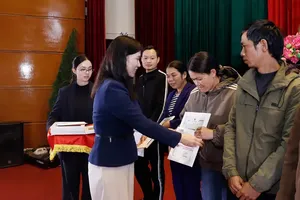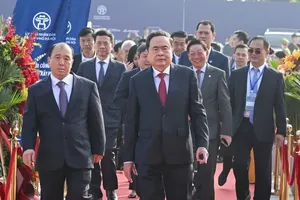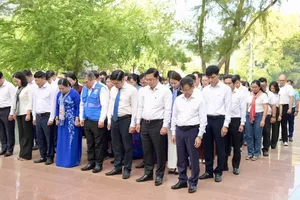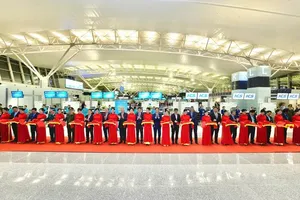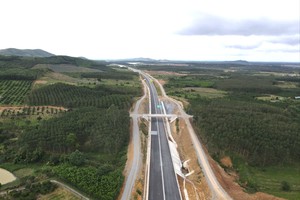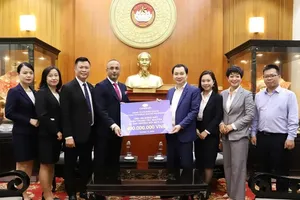The indigenous ethnic minority communities living in the rugged mountainous regions of the northern provinces of Vietnam have their own quintessential traditions and customs to celebrate Tet Lunar New Year.
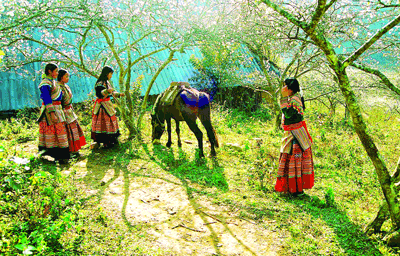
On the second day of Tet Lunar New Year, Hang Mi De, a male member of the Mong ethnic minority group from the Northern Province of Ha Giang, took a hunting knife hanging on his wall and stepped out to chop a Tet bamboo plant, to bring into the house to worship.
The air outside his home smells pure and sweet, the mountains are covered with mist and calm pervades his senses.
Amidst the mist, faint traces of red petals of peach blossoms awaken his senses to the true beauty of nature.
Hang Mi De chopped down a 3 meter bamboo plant, stripped its branches and leaves, only leaving a few at the top, then shouldered it before making his way back home.
A short way ahead, he met his wife and daughter-in-law, wearing traditional floral embroidered dresses, resembling colourful butterflies as they walked.
At the entrance to the village, Hang Mi De stuck the bamboo plant into a hole and filled it with mud. De’s wife and daughter-in-law then joined their hands to pray in front of the bamboo plant, while De and a guest drank wine sitting on a stone nearby.
De told his guest that his daughter-in-law was not having any children for a long time; hence they planted a Tet bamboo plant on the second day of Lunar New Year every year, to pray for a grandchild.
The Mong ethnic minority people are very poor, De said. Only on Tet they get a chance to eat meat and ate only vegetables the rest of the year. “It’s our custom to eat meat on Tet to wish for a prosperous year”, said De.
The Mong people offer twin cups of wine, one for the host and one for the guest, who is seated on the right of the host. When the owner of the house finishes his drink, he turns the wine cup upside down on the floor. The guest must turn it back up to have more wine. The owner and the guest take turns to turn the cup up, until they get drunk.
On the other hand, the Pa Then ethnic minority people love to dance around a huge bon-fire to welcome in the Lunar New Year. They believe that fire chases away ghosts and bad spirits and consider their fire dance as very sacred.
Hundreds of members of this ethnic community gather in a wide open space. Female members of Pa Then wear colourful dresses. As soon as the mantle of night falls, an elderly man of the village prays for a prosperous season, 12 Pa Then young men then strip to their waists and go around the fire three times, then fold their hands and seem to wait anxiously for something to happen.
It is well into the night. Only the dying embers of the huge bon-fire remain. Suddenly, a cry is heard “Let’s dance”, echoing into the mountain air. One of the 12 young men turns his face upwards and lets out a loud howl and abruptly jumps into the fire with bare feet.
The dying embers of the fire spray in all directions. The young man dances frantically and madly over the remains of the fire, resembling a giant bird fluttering over the fire. Other men watching are unable to control themselves and join in as well. They dance on the dying fire with bare feet, flipping the embers at times with their feet and at times trampling and crushing them into powdered pieces.
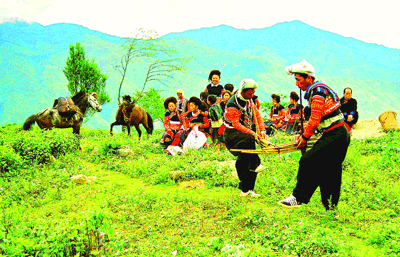
The dance reminds of days when primitive man struggled to reign in spirits and nature. The Pa Then ethnic minority community worships the Fire God, and traditionally they draw their strength each year during Tet from this form of worship.
Majority of people of the Phu La ethnic minority community (or Xa Pho, Bo Kho Pa, Mu Di Pa) live in the northern province of Lao Cai as their own lunar calendar coincides with that of the Kinh people.
Afternoon of December 30 on the lunar calendar, the Phu La ethnic minority people make offerings to their ancestors of stuffed sticky rice cake, head of a pig, fruit jam, white wine, sticky rice, oil lamps, embroidered kerchiefs, traditional costumes and two sugar canes. All offerings are placed on the altar for three days.
On the night of the thirtieth, elders join all the village people to sit around a huge bon-fire, drinking and smoking and wait to hear an animal cry out in the village, which will then be a foreboding, either good or evil, for the New Year.
In Nghia Lo town in the northern province of Yen Bai, from December 24-25 of the lunar calendar, the Thai ethnic minority people cook special green leaves and traditional cakes, and offer wine, jam and two sugar canes to their ancestors.
On the twentieth day of the twelve month of the lunar calendar, Thai people butcher a pig to welcome the New Year. Thai people don’t offer food at the altar and serve their guests left-over food from the pot. Village residents then take turns to serve guests.
The Si La ethnic minority people (or Cu De Xu, Kha Pe) in the northern province of Lai Chau don’t have any fixed day for Tet. As soon as they complete harvesting their crops they organize a festival to pray for the next bumper crop. On Tet they religiously offer dried squirrel meat to their ancestors.
The Ta Oi ethnic minority people in Truong Son Mountain area in the central province of Thua Thien-Hue also welcome New Year after the harvest in December of their own calendar.
Acha Aza Tet holidays or rice Tet, takes place for three days during the first days of the New Year. A respected elderly woman from the village is chosen as leader of the Tet festival to represent the entire Ta Oi ethnic minority people.


